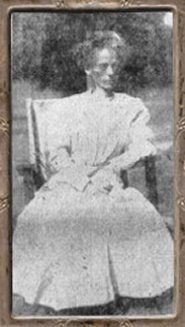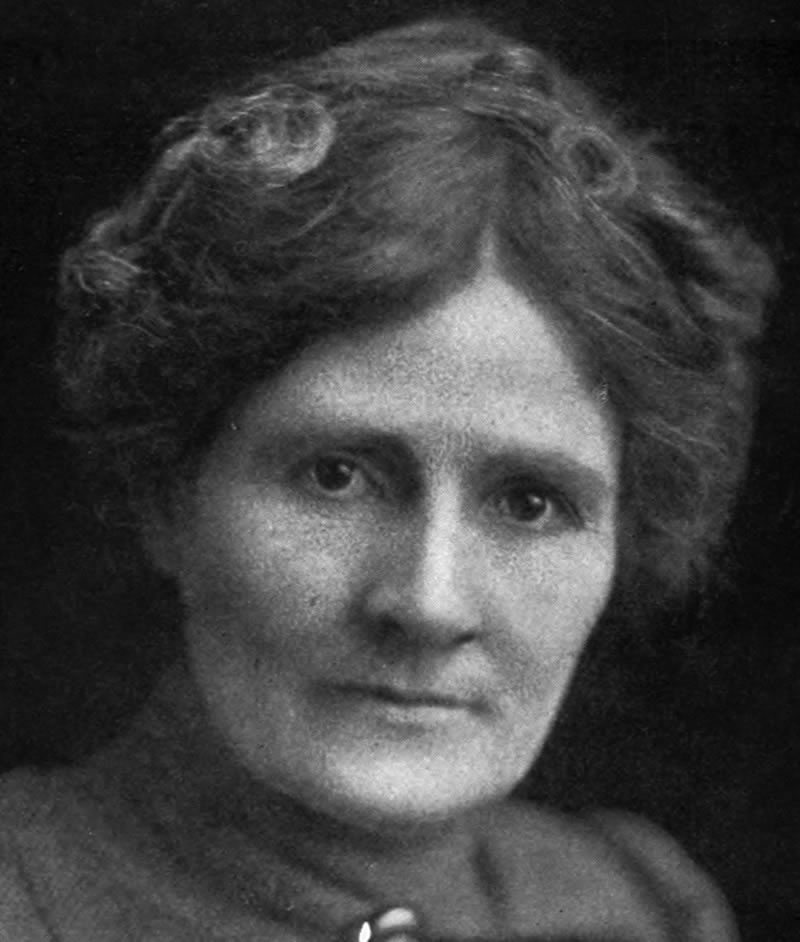Editor’s note: Harriet is still in Australia recovering from her injuries. She is expected to return to the US with her husband later this week. In the meantime, we have one more post by her, which was written before her injuries. We don’t know when she’ll have recovered sufficiently to resume her weekly blogging here, but we have a guest post for next week. After that, we’ll play it by ear. Finally, this post has been reposted under a new URL because of another WordPress issue; you might see duplicates in RSS feeds, and the old comments are gone. Sorry about that.
I recently learned of a real-life horror story that is all the more frightening because the horror is not supernatural fantasy but a matter of real humans torturing and killing fellow humans under the guise of medical care.
Linda Burfield Hazzard was an American quack doctor who put her patients on such stringent fasts that some of them died of starvation. She is thought to have been responsible for at least 14 deaths over one four-year period. She was convicted of manslaughter but was out of prison in two years and went right back to her old practices. She was one of a kind and is long gone, but there are lessons to be learned for today.
Who was she?
Linda Burfield was born in Minnesota in 1867. She had no medical training but was granted a license to practice medicine in Washington State under a grandfather clause. She was a follower of Edward Hooker Dewey, MD, who believed in the healing power of nature and had his patients abstain from food. Linda believed that excessive eating was the cause of most illnesses, and that fasting would remove toxins from the body, correct imbalances, and allow the body to heal itself. After practicing in Minnesota and later in Seattle, she opened a sanitarium, Wilderness Heights, in Olalla, Washington, on the shores of Puget Sound. Her patients were allowed to eat nothing but small amounts of dilute tomato and asparagus juices. They lost weight rapidly. An example of one of her diets can be found on Wikipedia in the form of excerpts from the diary of a patient who died of starvation under her care. In addition to fasting, patients were subjected to painful osteopathic manipulations, prolonged enemas, and other indignities. 40 patients died while under her care. She performed autopsies in her bathtub and alleged that they had died of unrecognized illnesses like cirrhosis rather than of starvation. The house she lived in still exists, and the original bathtub is still there. I wonder if the new owners think of her when they bathe.
The people who lived in Olalla were aware that patients were dying at her establishment; children were afraid to go near it, and when they saw the weakened patients out and about they laughed at them because they were unable to walk without falling down.
Her husband, Samuel Hazzard, was a con man and a drunk who had spent time in prison for bigamy. Together, they conspired to steal patients’ jewelry and clothing, they forged documents, they had patients falsely declared mentally ill and incompetent, and they got powers of attorney so they could take over their patients’ estates and enrich themselves. They even extracted the gold fillings from the patients’ corpses and sold them to a dentist.
The death of Claire Williamson
The shit hit the fan with the death of Claire Williamson. Claire and Dorothea (Dora) Williamson were wealthy British sisters who could probably be best characterized as the “worried well.” They had some minor complaints, but were vigorous and well enough to travel the world. They had always been interested in natural healing and had eagerly followed every new fad. They sought out Linda Hazzard in Seattle and later were patients in her sanitarium. The story of their decline and Claire’s death is told in the book Starvation Heights by Gregg Olsen. He spares no details. The description of how the sisters slowly wasted away is one of the most painful things I have ever read. They became fatigued, had difficulty walking, were in pain, and eventually became too weak to get out of bed. They were essentially kept prisoners and even denied access to their mail. The only reason their plight came to light was that Dora was able to smuggle out a message to a friend in Australia. By the time the friend arrived and got the authorities involved, Claire had died. She weighed less than 50 pounds at her death. Hazzard did an autopsy and said she had died of cirrhosis. Dorothea was shown the body but didn’t recognize it as her sister’s and believed another corpse that weighed more had been substituted. The funeral home was apparently in cahoots with the Hazzards.

Dora’s condition shortly after her rescue
After Claire’s death, the Hazzards tried to brainwash Dora into believing that she was insane and unable to care for herself; they tried to get guardianship so they could control the Williamson estate. With the help of the British consul, Dora was forcibly removed from the sanitarium just in the nick of time before she, too, starved to death. She looked like those pictures of walking skeletons from when the Nazi death camps were liberated.
It proved very difficult to get the local prosecutor to act, due to lack of motivation and lack of funds. When the case finally went to court, it was a circus. Hazzard’s defense was that the witnesses were all lying and the medical establishment had conspired against her out of jealousy, since she cured patients they couldn’t help. Her former patients were not allowed to testify. She tried to influence witnesses, grandstanded for the newspapers, and was proved to have forged Claire’s will as well as the last entry in Claire’s diary. She was convicted of manslaughter and sentenced to two to twenty years of hard labor, but was released after two years and was granted a full pardon by the governor.
Prison didn’t stop Hazzard
After her release, she went to New Zealand and practiced as an osteopath and dietitian for five years. Eventually she was found guilty of practicing medicine without a license and was fined £5 plus court costs. The next year she was right back in Olalla building a bigger sanitarium. Her Washington license had been revoked, but she got around the law by calling her sanitarium a school of health. She continued to supervise fasts there for 15 years until the building burned down. Three years after that, in 1938, she died while trying to cure herself by fasting. Poetic justice?
Why didn’t the sisters realize what was happening to them?
To me, the most appalling thing was that the sisters continued to believe in Hazzard’s starvation treatment until the bitter end. Couldn’t they see that they were dying? When they first consulted Hazzard they were walking around and travelling the world; soon they were too weak to walk. Surely they could see that their flesh had melted away and that 50 pounds was an unhealthy weight for an adult. They were completely under the thrall of Hazzard’s strong personality and they truly believed the starvation treatment was working and they were getting better.
Lessons to be learned
Thank goodness there are no Linda Hazzards today (that we know of), but there is much we can learn from her saga. We still have to deal with many of the same issues today.
Living without food. There are Breatharians who think they can survive by prana (the Hindu vitalistic force) alone, and there is an 83-year-old man named Prasad Jani in India who claims to have lived without food for 7 decades. Three years ago a Seattle woman named Naveena Shine embarked on an experiment to see if she could live on water, sunlight, and tea. She lost 20% of her body weight, developed worrying symptoms, and resumed eating after 44 days. In a previous article I described Ray Jardine’s 40-day water-only fast. Intermittent fasting is being seriously studied by scientists for weight loss and improved health. A recent historical novel, The Wonder, by Emma Donoghue, was inspired by a number of cases in Ireland of girls who stopped eating, usually because of warped religious beliefs and superstitions. (It’s a great read, by the way, about a nurse who was sent to investigate an Irish peasant girl’s claim that she hadn’t eaten for four months.)
Lack of prosecution. The laws are still not being enforced adequately. Quacks are getting away with practicing medicine without a license and licensed doctors are practicing quackery with impunity. The lack of effective action is epitomized by the Burzynski case. Despite lawsuits and medical board investigations, he is still garnering big bucks for his untested cancer treatments.
Defenses of quackery. Any quack can produce reams of patient testimonials. Satisfied patients idolize them as gifted healers, assuming that the quack treatment was the cause of their improvement, committing the logical fallacy of post hoc ergo propter hoc. When confronted, quacks insist that mainstream medicine is persecuting them and just trying to protect their own turf for purely financial reasons.
Women’s issues. Hazzard stood up for her gender and challenged the male-dominated medical establishment of her day. Serial killers are usually male, and she stands out as an exception to the rule. Her treatments were every bit as lethal as bullets, and arguably worse because of a slower death and more suffering.
Belief in implausible treatments. Public gullibility is alive and well. We have quackademia and there are homeopathic remedies in every drug store. The general public and many elected officials have a very poor understanding of science and hold pseudoscientific and anti-scientific beliefs.
Human psychology. How can we understand the mentality that led the Williamson sisters to continue to believe in a treatment that was obviously rushing them into an early grave? Because they believed so strongly, they were unable to see what ought to have been glaringly obvious to any observer. We see the same thing today in cancer patients who insist they are on the right course despite clear evidence that they are getting worse with quack cancer treatments.
Conclusion: We can learn from this
I live a scant 34 miles from Olalla, Washington, where all this happened. How had I never heard about it until now?
This is a story that deserves to be told. As Santayana said, those who cannot remember the past are condemned to repeat it. This is the story of a unique person’s crimes of murder, theft, and torture, but it is more than that. Many people let the Williamson sisters down: the quack doctor, her husband, the public prosecutors, the community of Olalla, the nurses who assisted with patient care, the state licensing board, the prison system, the governor who granted a pardon, the funeral home that aided in the deceptions, the coroner who failed to investigate the suspicious deaths, and the postal system that let the doctor intercept the sisters’ letters. And the patients themselves bear a large part of the responsibility for what happened. No man is an island; we all share responsibility for others. The Hazzard story can be useful as a wake-up call; as a community, surely we can do more than we are currently doing to protect our more vulnerable members.

